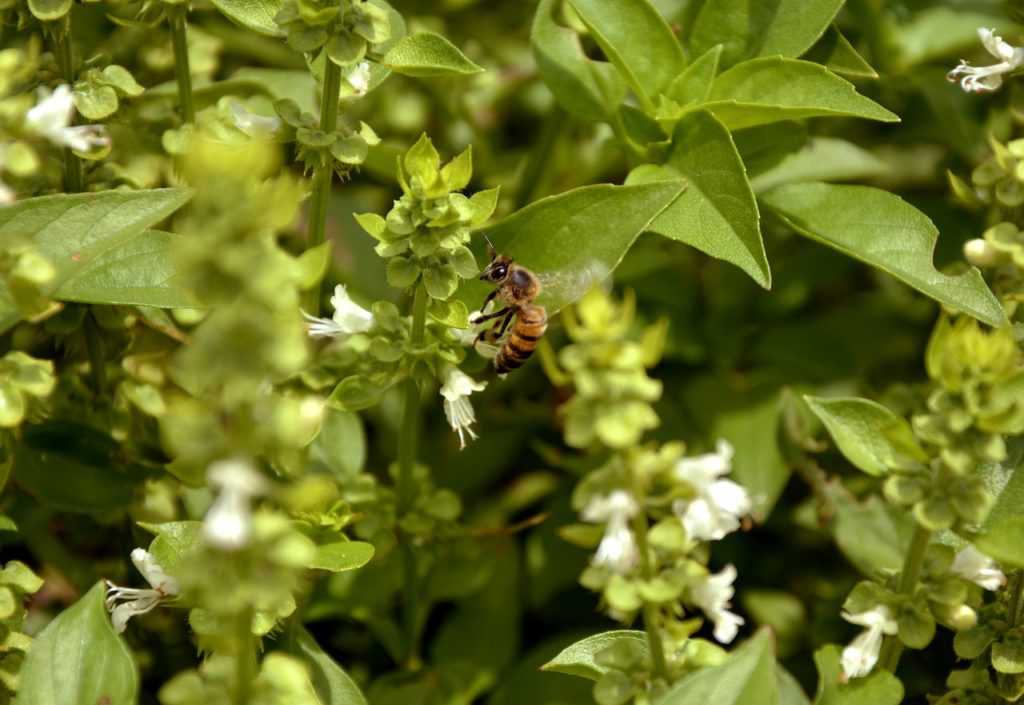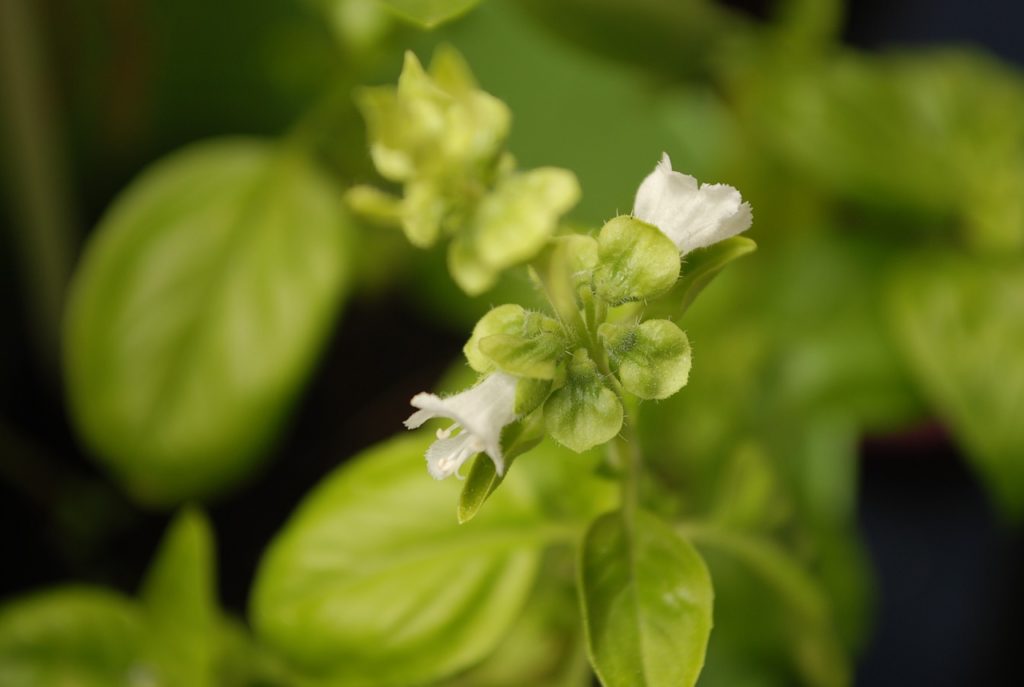Basil plants will bolt when the weather gets too hot, especially when the temperature is consistently above 80°F (27°C). Basil flowers will form on the end of the plant and the basil will go to seed. This will turn the leaves bitter and the stems will become woody. Prevent basil from bolting by planting it in early spring and harvesting it regularly.
Supermarket basil can often bolt rapidly after planting. The rapid change in temperature will trigger the plant to bolt and grow see. Basil will be grown out of season in greenhouses and shipped to supermarkets to be used easily in cooking. These plants can be tempting to plant out in mid summer but it can cause the plant to bolt. Basil is an annual plant and grows best went planted in early spring after frosts have passed.

This article will explore why basil plants bolt and how you can stop this from happening.
Why basil plants bolt
Basil plants will form flowers and seed pots when the plant is left untrimmed or when the weather turns hot in summer. At the end of the summer season the basil plant will be getting ready to reproduce for the next season and will flower and set seed.
The basil plant will lengthen, growing tall and reaching up high. Basil flower buds will form on the end of the stems and if left there they will be pollinated by insects. These flowers will then form small seed pods on the end of the basil plant.
When a basil plant bolts, growing flowers and setting seed the leaves will turn bitter. The plant will focus its energy on the flower stalk and seed growth and will stop growing new leaves. The flowering stem will harden going woody and holding the seed pod up.
If left on the seed swill dry and drop to the ground. These can be collected in a paper bag and replanted the next year.

How to stop basil plants from bolting
Here are my top tips for preventing your basil plant from bolting. This will keep it growing lots of leaves for your recipes and stop the flower and seed pots from forming on the end of the plant.
1. Prune regularly
Regular pruning is the key to stopping your basil plant from bolting during the spring and summer season. A basil plant that is left untrimmed will grow a long, tall stem and eventually a flower head on the end of the plant.
Pruning the plant by trimming off the top 1-2 inches off. Remove the top 4 leaves of the plant by pinching it off with your fingertips, trimming with kitchen scissors or using sharp secateurs. When harvesting large amounts, remove the top 1/3 of the plant to encourage it to branch out and grow new stems and leaves.
Regularly trimming basil, at least every 2 weeks during spring will prevent the plant from bolting, growing flowers and setting seed. This will give you lots of tender and sweet basil leaves for many months.
2. Plant basil in early spring
Planting basil in early spring after frosts have passed is a great way to prevent bolting. A mature plant will be triggered to grow flowers once the weather turns hot in mid and late summer. Plant new basil seedlings out in early spring and again in mid spring will give the plant more time growing leaves instead of bolting.
Basil plants can be available all year round even from supermarkets. Growing these out of season in the winter months or late summer season can lead to rapid bolting as the plant experience rapid temperature changes.
3. Liquid feed with nitrogen fertilizer
Feeding basil regularly with a dilute liquid nitrogen fertilizer will help to encourage more leaf growth and will delay bolting. Liquid nitrogen fertilizer will moisten the soil and encourage leaf growth, chlorophyll formation and new stems.
I like to use an organic nitrogen fertilizer like fish emulsion. This is a natural substance that will also work to feed soil bacteria which will help to break down and release nitrogen from the organic matter in the soil.
Slow release nitrogen fertilizers like pelleted chicken manure can be placed on the plant at the time of planting and again 4 weeks later for a longer lasting solution.
These are my top ways to prevent basil plants from bolting so the plant will keep producing soft, tender green leaves.
Can you eat basil after it bolts?
You can eat basil after it bolts but the leaves may be tougher, taste slightly more bitter and the stems may have hardened. The plant will be focusing its energy on growing flower buds and setting seed instead of leaf growth. The plant will be changing its chemical production to focus on seed growth and the taste will change.
While you can still eat basil leaves after it bolts, the flavor of the leaves will be bitter. Using them in cooked dishes is a great option so you can save the young new leaves to eat fresh.
What to do with basil that has bolted?
Basil that has bolted can be left to form seed. Basil flowers can attract pollinating insects to other fruiting plants in your garden. The seeds can be left to dry out and collected in a paper bag. Trim off the seed heads and place them in a brown paper bag to dry out for 2-3 weeks. Shake the bag and the tiny seeds should shake free of the flower buds.
What are some tips for harvesting basil?
When harvesting basil, make sure to pick the leaves from the top of the plant first, as they are the youngest and most tender. Use sharp scissors, pruning shears or pinch them cleanly to avoid damaging the plant. You can harvest basil leaves at any time, but it is best to do so in the morning when the oils are most concentrated. Store the leaves in a plastic bag in the refrigerator or freeze them for later use.
Basil Plants Bolting | Summary
Basil plants will bolt in late summer when the weather gets hot, growing flowers on the end of long stems and eventually forming seed. This can be prevented by trimming the basil plant regularly over spring and summer and feeding them with a liquid nitrogen fertilizer. Plant basil in spring to give it time to grow lots of leaves so you can harvest multiple times.
When you trim off the stems, the plant will grow back new tender stems to replace the old ones. This will keep the plant smaller and bushier with small, tender leaves.
Happy planting
Basil
- Caterpillars Eating Basil | 12 Easy Solutions + Natural Recipe
- Best mulch for herbs | Basil, Parsley Rosemary + More
- Is basil a perennial? | Annual & Perennial Basil Comparison
- Can you plant basil and mint together?
- Growing basil with tomatoes | Complete Guide
- Can you plant basil and parsley together? | Grow Guide
- How deep do basil roots grow? | 8-12 inches + basil grow guide
- Leggy Basil Plants: How to stop basil going leggy
- Why does basil turn black? | Top 4 Reasons + Solutions
I am an accredited practicing dietitian, experienced gardener and a dedicated cook. I love writing and sharing my experience so you can learn from my successes and mistakes.
